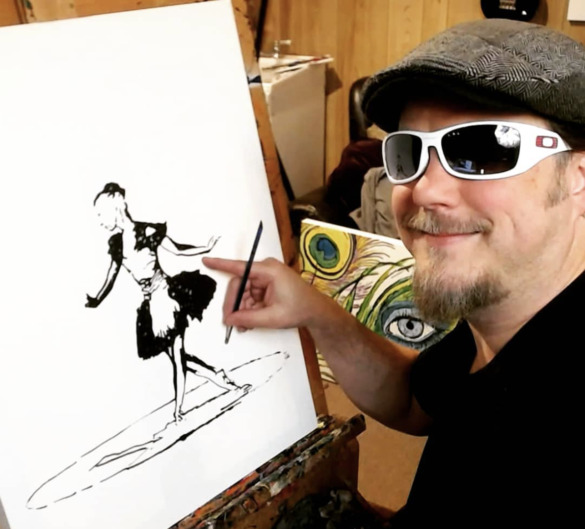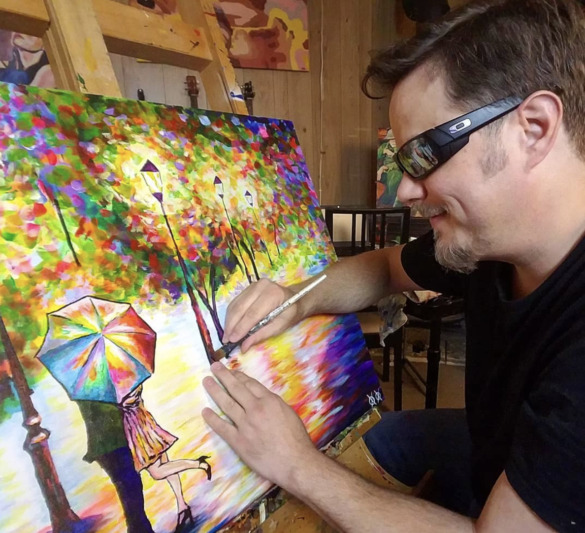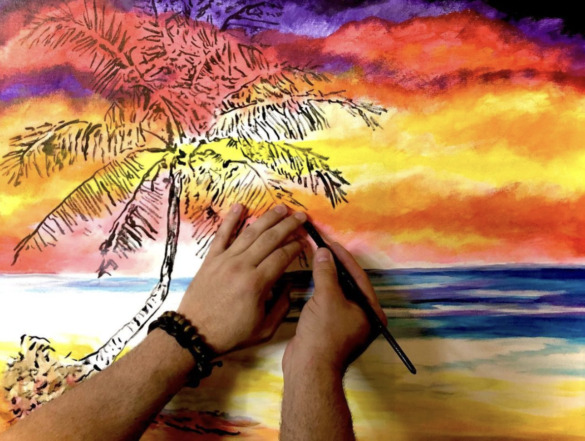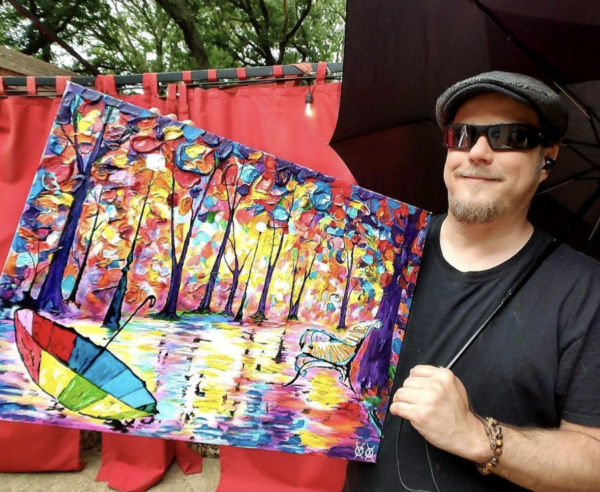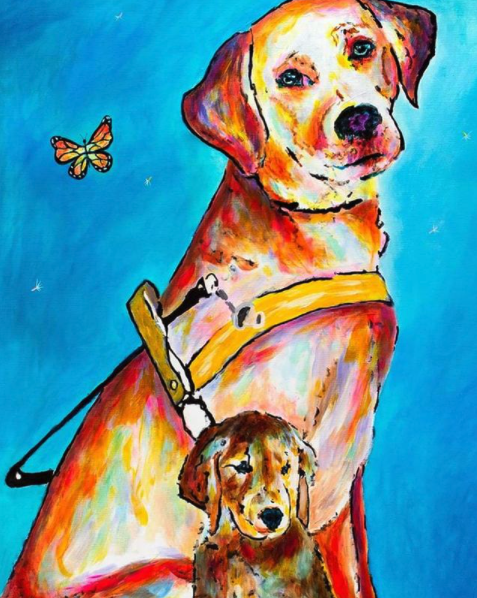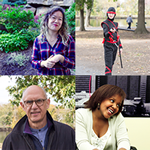Faces Behind the Screen: John Bramblitt
Quick Links
<< Return to all “Faces Behind the Screen” stories
John Bramblitt is an internationally recognized artist living in Denton, Texas, whose work has been sold in over 120 countries. He has appeared on CBS Evening News with Katie Couric, ABC, NBC, FOX, Discovery Channel, and BBC Radio and TV, has been featured in The New York Times and Psychology Today, and is the subject of the award-winning documentary shorts Line of Sight and Bramblitt. John is also blind.
Currently, John works as a museum consultant in developing programs designed to include everyone, no matter their ability or disability. He has received three Presidential Service Awards for his innovative art workshops, which span the gap between beginning and professional artists and include adaptive techniques for people with disabilities.
John is the author of the award-winning book Shouting in the Dark, which tells the story of his life and journey navigating blindness and how he ultimately rekindles his joy, passion, and relationships through art.
Read on to learn more about John’s journey and work.
Part 1
Do you identify as blind or low vision?
JOHN BRAMBLITT: It depends on who I’m speaking to. If it’s people who don’t know a lot about blindness, I’ll just say blind. If it’s people that do, then I’ll say visually impaired. But either is fine with me.
Can you explain how and when you lost your vision? What was that process and transition like?
JOHN BRAMBLITT: I was born with epilepsy and have had seizures all my life. When I was a pre-teen, I got Lyme disease. Since I was having a lot of trouble with seizures, the Lyme disease went undiagnosed for years and caused nerve damage. I then started having these seizures called status epilepticus, which would stop my breathing. The seizures damaged the occipital lobe in my brain, where vision happens.
At the time, we didn’t think of it as a vision problem; we just thought it was a problem with my epilepsy and that if we could get the seizures under control, then everything would be okay. But when I was in college, I had more massive seizures that caused more damage to the occipital lobe, and it became apparent my vision was damaged.
In April of 2001, I went to a low vision specialist for the first time. My vision was 20 over 400, which is twice the legal limit for blindness. A couple of months later, it was 20 over 800. Within a month of that, they couldn’t measure my vision anymore.
To be honest, even though I’d been having trouble with vision, whenever my doctor told me I was blind and that it was only going to get worse, I felt like I was punched in the stomach. I honestly felt like they would tell me they had a magic pill or treatment. But when they said my vision was gone and wouldn’t come back, it was the worst feeling. When I first lost my eyesight, I thought it made me different from everyone. I felt very isolated.
But I came to learn over the years that everybody has something in life that seems insurmountable. So, instead of blindness making me different from everyone else, I think it made me more like everyone else because we all have a problem. We all have this thing that we have to deal with in life. It might not be a disability, but everyone has some huge, insurmountable challenge.
That’s a neat perspective and an amazing way to look at it. Everybody has something, whether it’s known to others or not.
JOHN BRAMBLITT: It’s almost harder if you have a hidden disability. If you have epilepsy, then you can sort of pass. Nobody knows you have a disability, so you might be concerned it’ll come out. I work at camps with a lot of children who have epilepsy. When the kids go to camp and meet other children with epilepsy, a hidden disability, it’s like the world opens up, and they realize they don’t have to keep it private anymore. If they have a seizure, the world won’t break.
In some ways, I think having a visual disability is sometimes easier. When you see me out in public and I have my guide dog or white cane, everybody knows I’m blind. So, automatically, people deal with it, and you don’t have that fear of coming out.
What is the most common mistake sighted people make when interacting with someone who is blind or has low vision?
JOHN BRAMBLITT: It’s that they think we can’t do anything. When I was a college student and lost my eyesight, I was able to stay in school. I was at a very progressive university, and I was getting “incompletes” in classes. While I was learning how to use a white cane, I also learned to use screen readers, Braille, and all the other stuff I needed to know. I needed someone to guide me to classes, but I was proficient enough with a white cane to take myself to class after a year.
Sometimes I would walk alone to a coffee shop, and when I would stand at the counter with my cane, somebody would ask, “How’d you get here?” And I would think, well, I used the sidewalk. It wouldn’t even occur to me that they were asking how I could go down the street and find the coffee shop as a visually impaired person. I got that a lot at first. After a while, people got used to it, but I travel a lot now, so it’s still surprising sometimes. People just don’t expect you to be able to do the most basic things.
Many times, people get their ideas about what people with disabilities are like from movies, which is the worst place to get your information. In movies, when someone loses their eyesight, they don’t remember anything. Their mother can walk into the room, and they’re like, Mom, is that you? You’ve heard this person your entire life. You know who it is. It’s so funny, but it can be frustrating.
What would you say is the best thing about being visually impaired?
JOHN BRAMBLITT: My art changed when I lost my sight. I was always very visually oriented, but I didn’t paint before losing my eyesight, I just drew. I loved to draw. When I was sighted, if I could do a drawing of someone and the drawing looked like the person, it was a good drawing. But after I lost my eyesight, it needed to change.
When I started getting back into art again, I wanted my drawings to look like the person, but it was more important it felt like the person. I was so interested in perception. For example, if a family member of yours walked into a crowded room, everybody would see the same person. They would see the clothes they’re wearing, their haircut, they would hear them talking. Everybody would get the same information about that person. But what they thought and felt about the person could be completely different, and I thought that was so interesting because it’s the same visually.
I also didn’t use color or paint before losing my eyesight. But after losing my sight, the colors had to get brighter and explosive because I had to show emotion and ideas.
Many people would consider painting such a visual art, so what senses or techniques do you use instead of vision?
JOHN BRAMBLITT: Sense of touch. After I learned how to use a white cane, I thought, well, if I can use my sense of touch to go down these sidewalks and cross streets without getting hit by a car or knocking over too many people, then surely I can get across something much smaller like a canvas if I use the same techniques. So I used the orientation and mobility techniques you use with a white cane or a guide dog.
When I draw, I use a special paint that dries fast. When I first started, I had to use giant thick lines to feel them because my sense of touch hadn’t developed much. But now I use much thinner paint that I can still touch and feel. It almost feels like rubber.
If you’re a sighted artist, you only use your eyes for a couple of things. One is to know where you are and see where you’re putting the paint down, and the other is to see where you’ve been, everywhere that you’ve put the paint. If you’re blind, you use your sense of touch to do that for all aspects of life, so it’s the same thing on a canvas. Whenever I make a line on a canvas, I can touch and feel where that line is, and then I can feel where I want to put another line. I use one hand to do the work that my eyes would do.
Then I mix the paint, which I came up with to make each color feel different. Paint is made of sticky stuff that holds the paint together, which is called a medium, and that’s what the paint feels like. And the color for the paint is pigment. So you’ve got the sticky stuff of paint, and then you’ve got the color of paint, and you can mix different mediums into paint to make it feel different. I can mix a white so it feels like toothpaste or a black so it’s oily and runny. If I want to make a color halfway between that, a gray, I can mix for a texture right between the two.
When I lost my eyesight, it didn’t occur to me that I could draw again. It took a year for the idea to even cross my mind. When I started, I was drawing simple things like squares, circles, and triangles. I couldn’t do any shading or blending. But over the last 20 years, you can see my progression of learning how to blend and use shadows and more colors.
The more I painted, the happier I was and the brighter the colors needed to be. If you look at paintings from 2005 or 2006, they’re very muddy and dark. But if you look at today’s paintings, they’re very bright and happy because I’m a much happier person now than I was back then.
Part 2
I’d love to hear about your work as an accessibility consultant for museums.
JOHN BRAMBLITT: I’ve been working for over 10 years with museums. I started out doing painting workshops for nonprofits and loved it. Even if I was talking to people that didn’t have a visual impairment, maybe they were soldiers with PTSD, children with autism, or adults with Alzheimer’s, we all got each other. We knew we were dealing with challenges in our lives. I was talking to people that understood me, and it was awesome.
Museums then started contacting me because they wanted to be more inclusive, so I started doing free workshops and designing programs. I’ve now worked with the Guggenheim, Metropolitan Museum of Art, Dallas Museum of Art, and so many others. When I first started, I had about 30 different workshops for different groups. But I then realized that if I made the workshops multi-sensory, then I didn’t need a separate workshop for everyone. Everybody could have the same workshop at the same time. If you use a wheelchair, if you use a white cane, or if you don’t have a disability, you use the senses you have in the way you’re used to. So I started coming up with multi-sensory art workshops.
I ended up with museum workshops that would have a professional artist sitting next to a child who had been blind since birth, sitting next to a person who uses a wheelchair, and then maybe the next 10 people didn’t have a disability. Instead of being this great chaotic mess, it worked. People had the best time.
The workshops are also free. Art came to me when it shouldn’t have, and people with disabilities often don’t have the finances to try a new hobby—so being able to learn for free helps. Since then, the artwork has gone to over 120 countries. I never thought anyone would ever want to see a painting of mine. I thought I was nuts to paint. I just painted to connect with people. I was so depressed and angry that I had to reach out through art, but I never thought it would work or that anybody would be on the other side of that connection. That’s l why I paint. I was painting before I got on this interview with you, and I’ll be painting right after. Painting is my way of connecting with people. I can’t express how blessed I feel that people out there see my artwork and connect with it.
Are there any other tools or technology besides your guide dog and white cane that you use to assist you in daily life?
I learned to read Braille in college. I use it for my paint tubes, but most of the reading I do is using computers with screen reader software. I also have an Amazon Alexa in every room. When I first lost my eyesight, accessible technology was so much more expensive, but now there’s software on your phone that will talk to you. It’s incredible what’s out there now that just makes life more accessible.
I also use my smartphone with my guide dog. With a smart dog and a smartphone, I can do pretty much anything. I travel quite a bit, and if I’m somewhere I’ve never been, I can ask my phone if there’s a coffee shop that I can walk to. It’ll give me directions, and then I can tell my dog the directions. I can tell Eagle, my dog, to find left, find straight. My phone will tell me to walk 200 feet, so I’ll tell Eagle forward. If the door is on the left, I can tell Eagle to find left, and she’ll find the door. And then she’ll find the counter inside and the chair.
Modern guide dogs are incredible, and with technology, it’s just amazing. And that’s something I’m always trying to tell people. Most people who lose their eyesight are older, and when they have to change the habits they’ve had their whole lives, it can feel like life is over. And I’ll be honest, it is a huge adjustment. But once you’ve made that adjustment, it’s made. You’re done. You’ve learned the new techniques. You’ve learned how to adapt. After a while, you don’t even think about it. I remember the first few times at night when I would have dreams in which I was blind. I’d wake up and think, oh, that was weird. For the longest time, I was sighted in my dreams. Then suddenly, my brain finally adapted.
What was the process of getting a guide dog and being matched with her?
It took about three years for my first guide dog, Echo, who’s now retired. I’ve had Eagle for almost three years. Your cane training has to be good to get a guide dog because you use those techniques with the guide dogs. It costs about $50,000 for guide dog school, so they want to make sure the dog is going to someone who knows how to use them.
You have to train with a guide dog, too, and you also have to be a person who travels quite a bit or has a job that you go to every day. They don’t want to give a guide dog to someone that’s just at home all the time because you don’t need the guide dog for that. You’ve got to go through an interview process and a personality test to get matched up with a dog, too, to make sure you’ll get along. And they match your stride and how much you want to travel.
It took me about three years to get a guide dog, which is slightly longer than normal. But I had to be medically cleared because of epilepsy to make sure it wasn’t going to be a problem when I was out and about with a guide dog.
Have you ever used audio description? If so, what are your thoughts on it?
I’ve used it a little bit. I don’t use it a lot because I have a 12-year-old son who’s like a living audio description, but I think audio description is wonderful. Once, I was listening to a movie I had seen when I was sighted. I remembered it was a couple sitting at a table, saying a few words. But the person who did the audio description knew a lot about wine because when the waiter brought a bottle of wine to the table, the describer starting talking about the mild notes of almond and the type of wine. It didn’t have anything to do with the scene, but it was kind of interesting.
Most of the time, audio description is very specific to what’s going on. I think it’s awesome that it’s there because there are movies where you would have no idea what’s going on without it. I’ll often listen to a movie three or four or five times from different perspectives, and then I’ll listen to it with the audio description to fill it all in.
If there was one piece of advice you could give, what would it be?
JOHN BRAMBLITT: My piece of advice would be to fail. Fail a lot, and don’t be afraid of failing. If you’re not failing in your life, you may not be trying enough new things. Give yourself the freedom and the license to fail.
I did a portrait once of Jeff Bridges. I really admire him, and I asked him for advice. If I’m around anybody that I admire, I usually ask them that question. He said, don’t be afraid to fail. You’ve got to fail a lot. And I thought that was so cool.
A few months later, I was at a conference talking to Don Hahn, a painter and the producer behind Disney’s top 20 movies. We were up at 2 o’clock in the morning working around the fireplace, and I asked him the same question. He said you’ve got to fail. Don’t be afraid of failing. And I thought, well, my goodness. All these people that are much more successful than I am, that are much more talented than I am, have the same bit of advice. That has to mean something.
I think a lot of times, we’re our own harshest critics. We won’t let ourselves put ourselves out there. We’re so afraid of getting it wrong that we won’t try something new. We’re so worried about making fools of ourselves that we don’t try. So, make a fool of yourself. Go out there and make lots and lots of mistakes because it’s the successes that stick. That’s what you’ll remember.
—
Faces Behind the Screen would like to thank John Bramblitt for participating in our storytelling project. If you’re interested in sharing your story with us, fill out our nomination form.
Faces Behind the Screen is a storytelling project focusing on members of the Deaf and hard of hearing community.


